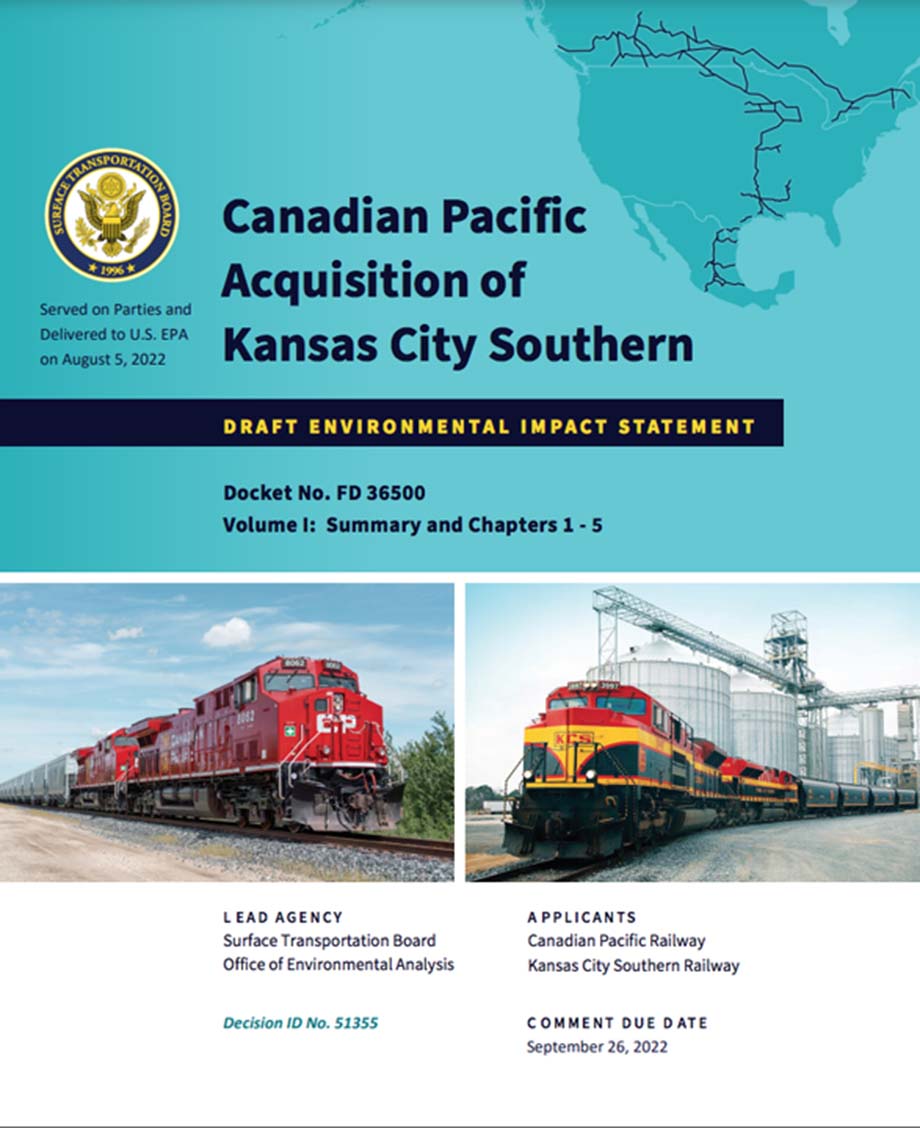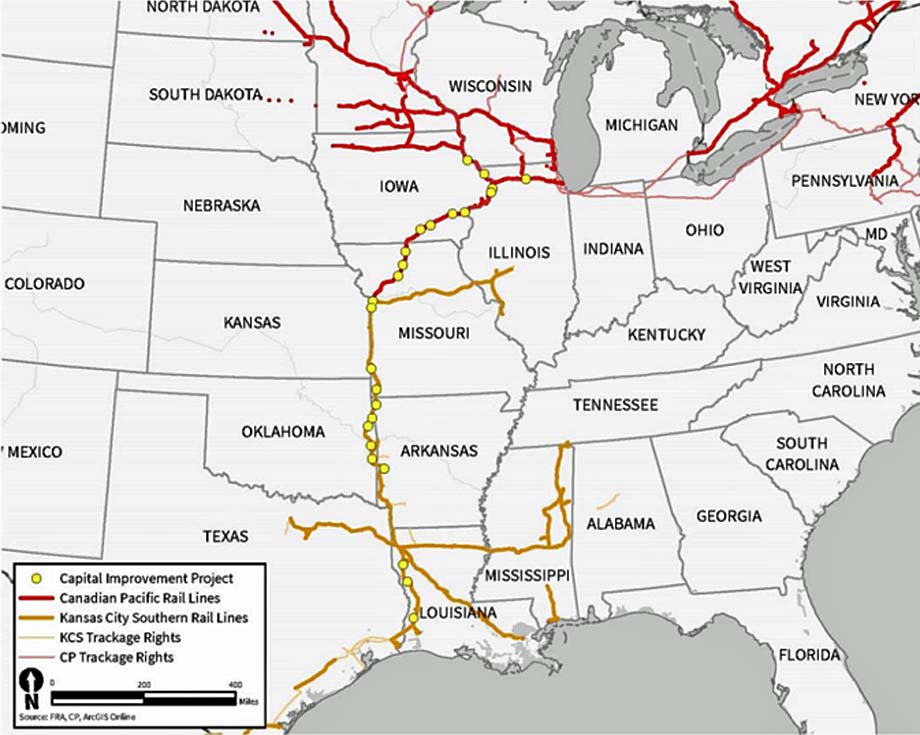
New York New York USA
Washington District of Columbia USA - STB's Office of Environmental Analysis (OEA) has been working
on the Draft EIS since February 2022, when it decided on the scope of its environmental review of the proposed Canadian
Pacific–Kansas City Southern combination, CPKC.
(In September 2021, the two Class I railroads agreed to merge, two months later, STB accepted for consideration their
merger application.)
"The combined CPKC network would include approximately 20,350 miles of track in total, including approximately
8,600 miles in the U.S., and would extend from Canada, through the U.S., and into Mexico," according to the Draft
EIS.
"The Applicants [CP and KCS] expect that the proposed acquisition would create new operational efficiencies and
would divert freight from other railroads and from trucks. As a result, rail traffic would increase on some rail lines
in the combined CPKC rail network (ranging from eight to approximately 14.4 additional trains per day, on average, on
CP and KCS rail lines between Chicago, Illinois, and Laredo, Texas.). To support this expected increase in rail
traffic, the applicants plan to make capital improvements within the existing rail right-of-way, which would include
adding new passing sidings, extending existing sidings, adding a section of double track, and adding facility working
track at a total of 25 locations along the combined CPKC network. The Board's Office of Environmental Analysis (OEA)
prepared this Draft Environmental Impact Statement (Draft EIS) to analyze the environmental impacts of the proposed
acquisition. OEA also considered the No-Action Alternative, which would occur if the Board were to deny authority for
CP to acquire KCS. Under the No-Action Alternative, OEA anticipates that rail traffic would only increase on the CP and
KCS networks as a result of general economic growth and that the applicants would not add the planned capital
improvements. The Draft EIS describes the potential direct, indirect, and cumulative environmental impacts of the
proposed acquisition on freight and passenger safety, grade crossing safety, delay, truck to rail diversion, intermodal
facility traffic, noise, air quality, climate change, energy, cultural resources, hazardous material release sites,
biological resources, water resources, and environmental justice."
Based on consultation with federal, state, and local agencies, consultation with tribes, input provided by
organizations and the public, and its own independent environmental analysis, OEA concluded in the Draft EIS that
"apart from train noise, which could result in adverse impacts at some locations, the potential adverse impacts of
the Proposed Acquisition would be negligible, minor, and/or temporary."

Specifically, OEA said it expects:
- That the proposed acquisition would result in:
- "only minor adverse impacts" on freight rail safety. Additionally, OEA said the applicants have proposed "voluntary mitigation that would minimize the potential for incidents to occur during rail operations and would minimize the potential impacts of any incidents that do occur."
- "negligible impacts" on passenger rail safety.
- the number of hazardous material releases along rail lines and at rail yards remaining "low."
OEA noted that the applicants have proposed "voluntary mitigation that would minimize the potential for incidents to occur during rail operations and would minimize the potential impacts of any incidents that do occur. Pursuant to 49 C.F.R. Part 1106 and the Federal Railroad Administration (FRA) regulations at 49 C.F.R. Part 244, the applicants also prepared a proposed Safety Integration Plan (SIP). The proposed SIP describes the applicants' proposed process and timeline for merging the operations of CP and KCS, as well as the safety implications of merging these operations.";
- That the proposed acquisition would result in "only minor adverse impacts" on safety at highway/rail
at-grade crossings and on grade crossing delay. Additionally, applicants have proposed "voluntary mitigation
that would mitigate impacts on safety and delay at grade crossings.";
- That the proposed acquisition "would not result in any adverse impacts" to traffic and roadway systems
as a result of truck-to-rail diversions;
- That based on the "existing capacity of local roads serving intermodal facilities where activity could
increase as a result of the proposed acquisition, OEA has concluded that increased truck traffic on those roads
would not result in any adverse impacts.";
- That "the projected increase in rail traffic from the proposed acquisition would make rail-related noise more
frequent, which would result in a higher day-night average noise level (Ldn) at many [noise-sensitive] receptors
[including residences, schools, hospitals, nursing homes, and places of worship." OEA explained that "the
applicants have voluntarily proposed mitigation measures to help address potential noise impacts, including a
commitment to fund the improvements necessary to maintain existing Quiet Zone designations in communities where the
proposed acquisition might otherwise cause the designation to be lost. OEA is also recommending additional
mitigation measures to address noise impacts that would require the applicants to maintain rail and rail beds,
comply with FRA regulations establishing decibel limits for train operations, consider lubricating curves where
doing so would reduce noise, employ other safe and efficient operating procedures that could effectively reduce
noise from train operations, and promptly respond to communities interested in establishing Quiet Zones. Even if the
Board imposes these mitigation measures, however, OEA expects that the proposed acquisition would result in
unavoidable adverse noise impacts.";
- That the proposed acquisition "would not result in an increase in overall air emissions and could result in
an overall decrease in emissions," but it would "change the local distribution of emissions by diverting
trains from other rail lines and OEA expects that localized emissions of air pollutants from locomotives would
increase along some rail line segments within the CPKC system. In particular, OEA's analysis shows that the
projected increase in rail traffic would result in nitrogen oxides (NOx) emissions in excess of the EPA's de minimis
thresholds in three nonattainment areas for ozone. The estimated increase in NOx emissions would be less than one
percent of the applicable emissions budget for mobile sources in each nonattainment area and therefore should not
adversely affect enforcement of applicable State Implementation Plans for the nonattainment areas. Aside from NOx
emissions, emissions of all other criteria air pollutants and hazardous air pollutants would be well below de
minimis thresholds, and air emissions resulting from the Proposed Acquisition would be minimized by the Applicants'
voluntary mitigation measures for air quality and climate change.";
- That the proposed acquisition "would not adversely affect the transportation of energy commodities or energy
efficiency.";
- That the proposed acquisition "would have No Adverse Effect to historic properties listed in or eligible for
listing in the National Register. Further, OEA is recommending mitigation requiring the applicants to develop and
implement a plan for archaeological monitoring during construction and addressing any unanticipated discoveries of
archaeological sites or associated artifacts during construction.";
- That the applicants' "voluntary mitigation measures and OEA's additional recommended mitigation measures,
would avoid or minimize potential impacts related to hazardous materials release sites at the locations of the
planned capital improvements." OEA explained that it "identified hazardous material sites in the study
areas for five of the 25 planned capital improvements and concluded that four capital improvements have the
potential to impact hazardous material release sites.";
- That the projected increase in rail traffic on certain rail lines in the combined CPKC system "would not
adversely affect" plants, fish, or habitat. Additionally, considering the applicants' "commitments, OEA,
in consultation with USFWS, has concluded that the proposed acquisition may affect, but is not likely to adversely
affect the Indiana bat, northern long-eared bat, and Ozark big-eared bat, and would have negligible impacts on other
biological resources.";
- That the "probability of an incident occurring that could result in a release of hazardous materials into
waterways or onto the ground where it affects groundwater is and would remain very low." Additionally, OEA has
concluded that "the planned individual capital improvements could temporarily or permanently impact between
0.00 and 0.53 acres of surface waters and between 0.00 and 6.43 acres of wetlands, depending on the location. These
impacts would be avoided or minimized by the implementation of the applicants' voluntary mitigation measures and
OEA's additional recommended mitigation measures. OEA also concludes that the proposed acquisition would have
negligible impacts on ground water and water quality.";
- That "noise would affect certain EJ [Environmental Justice] populations (including minority populations,
low-income populations, or American Indian tribes), but noise impacts would not be disproportionately borne by those
EJ populations. Indeed, based on OEA's analysis of the demographic data for census block groups and communities
along the combined CPKC network, most receptors that would experience adverse noise impacts are located in non-EJ
populations. To minimize noise impacts on EJ populations, OEA is recommending mitigation requiring the applicants to
conduct proactive and targeted outreach to minority and low-income populations that would experience adverse noise
impacts as a result of the proposed acquisition to provide information about the process for establishing Quiet
Zones. The applicants have also voluntarily proposed mitigation measures related to EJ.";
- That "several reasonably foreseeable projects and actions, could increase passenger rail traffic on certain rail lines in the combined CPKC network at about the same time as the proposed acquisition. Due to the low number of additional passenger trains that these projects could add, cumulative impacts on passenger rail safety, air quality, grade crossing safety, and grade crossing delay would be negligible."

OEA noted that if the STB decides to approve CP and KCS's formation of CPKC, it "could impose the applicants'
voluntary mitigation measures and OEA's additional recommended mitigation measures as conditions of that
decision."
Comment Period
Individuals, agencies, organizations, tribes, and other interested parties may submit written comments electronically
through the STB's environmental comment form, by 26 Sep 2022.
Additionally, oral comments may be provided at one or more of the in-person and online public meetings that OEA will
hold during the public comment period, which will cover only the environmental issues raised in the case.
In-person public meetings will take place 12 Sep 2022 in Itasca Illinois, 13 Sep 2022 in Davenport Iowa, 14 Sep 2022 in
Excelsior Springs Missouri, and 15 Sep 2022 in Vidor Texas.
Online public meetings will take place 7, 8, and 19 Sep 2022.
For more information on submitting comments and participating in in-person and online meetings, visit the STB-sponsored
project website.
STB will hold a separate public hearing on 28, 29, and 30 Sep 2022, at the agency's headquarters in Washington, D.C. to
hear comments on the merits of CPKC.
Next Steps
Following issuance of the Draft EIS and the 45 day public and agency comment period, OEA is slated to prepare and issue
a Final EIS.
The Final EIS will respond to the comments on the Draft EIS, present OEA's final conclusions regarding the potential
environmental impacts of the proposed merger, and set forth OEA's final recommendations to the STB, including
recommended environmental mitigation measures.
After OEA publishes the Final EIS, the STB is expected to issue its final decision on whether to approve the CPKC
merger.
According to STB, in making its final decision, it will consider the entire record, including the record on the
transportation merits, the Draft EIS, Final EIS, and all public and agency comments.
If the STB decides to authorize the merger, it may impose conditions on the applicants, including environmental
mitigation conditions.
Marybeth Luczak.
(likely no image with original article)
(usually because it's been seen before)
provisions in Section 29 of the
Canadian Copyright Modernization Act.
